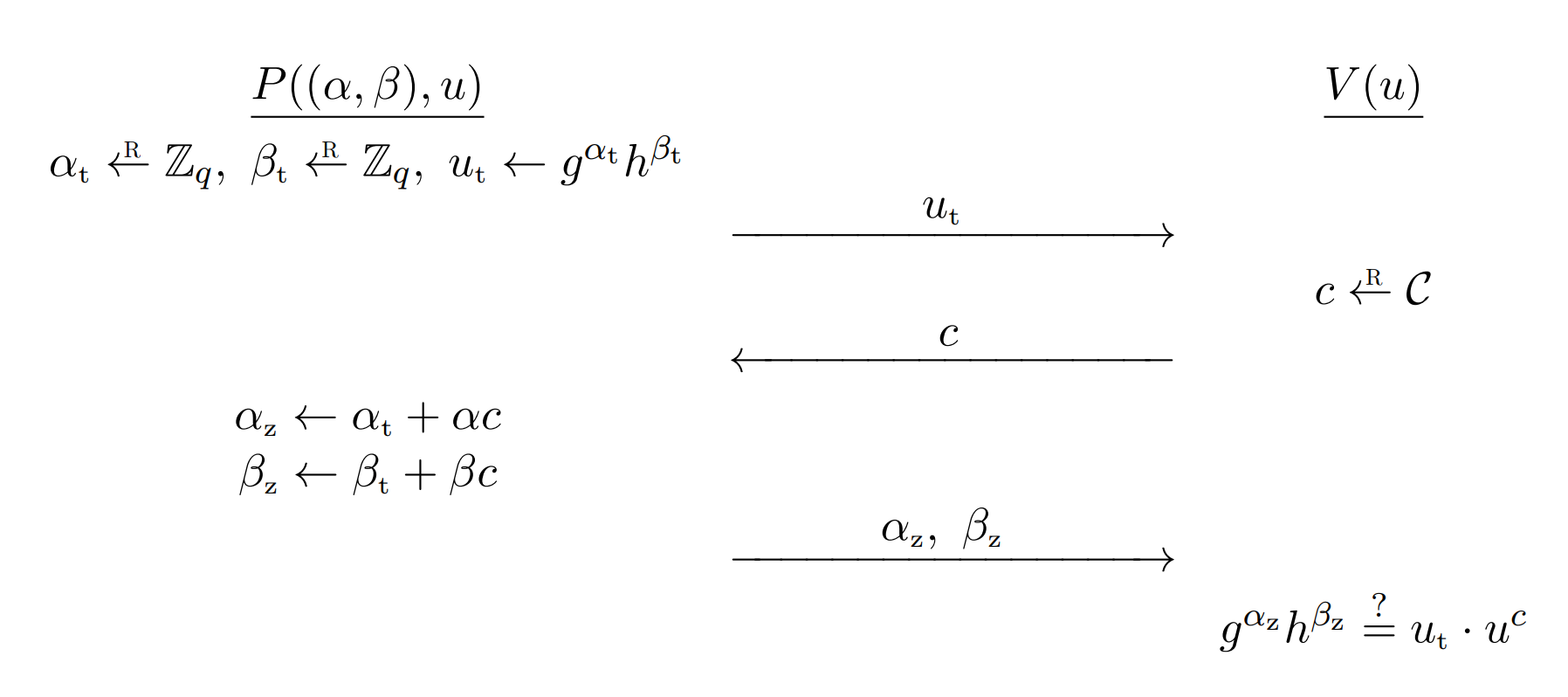ZKP Sigma Protocol
Sigma Protocol
Introduction
Sigma protocols are a specific type of interactive zero-knowledge proof (ZKP) that are known for their efficiency and simplicity.
They involve three distinct phases between a prover and a verifier:
- Prover: P ( x , y ) P(x,y) P(x,y)
- Verifier: V ( y ) V(y) V(y)
- Commitment: The prover sends an initial commitment t t t to the verifier, often involving a secret value.
- Challenge: The verifier responds with a random challenge c c c.
- Response: The prover calculates a response z z z based on the challenge and their secret knowledge and sends it to the verifier.
- Evaluation: Upon receiving prover’s response z z z, the verifier outputs either accept or reject, which must be computed strictly as a function of the statement y y y and the conversation ( t , c , z ) (t,c,z) (t,c,z). In particular, the verifier does not make any random choices other than the selection of the challenge: all other computations are completely deterministic.
Example: Okamoto’s protocol
Okamoto’s protocol allows a prover to convince a skeptical verifier that he “knows” a representation of a given u ∈ G u \in \mathbb{G} u∈G, without revealing anything about that representation to the verifier.
A witness for the statement u ∈ G u \in \mathbb{G} u∈G is ( α ; β ) ∈ Z q 2 (\alpha; \beta) \in \mathbb{Z}_q^2 (α;β)∈Zq2?such that g α h β = u g^{\alpha}h^{\beta} = u gαhβ=u, i.e., a representation of u u u. Thus, in this example, every statement has many witnesses.
- Prover: P ( ( α , β ) , u ) P((\alpha, \beta), u) P((α,β),u)
- Verifier: V ( u ) V(u) V(u)
- The prover computes α t ← G \alpha_t \leftarrow \mathbb{G} αt?←G, β t ← G \beta_t \leftarrow \mathbb{G} βt?←G, u t ← g α t h β t u_t \leftarrow g^{\alpha_t}h^{\beta_t} ut?←gαt?hβt? and sends the commitment u t u_t ut? to the verifier.
- The verifier computes a random c c c and sends the challenge c c c to the prover.
- The prover computes α z ← α t + α c ∈ Z q \alpha_z \leftarrow \alpha_t + \alpha c \in \mathbb{Z}_q αz?←αt?+αc∈Zq?, β z ← β t + β c ∈ Z q \beta_z \leftarrow \beta_t + \beta c \in \mathbb{Z}_q βz?←βt?+βc∈Zq? and sends the response ( α z , β z ) (\alpha_z, \beta_z) (αz?,βz?) to the verifier.
- The verifier checks if g α z h β z = u t ? u c g^{\alpha_z}h^{\beta_z} = u_t \cdot u^c gαz?hβz?=ut??uc. if so, the verifier outputs “accept”; otherwise, the verifier outputs “reject”.

本文来自互联网用户投稿,该文观点仅代表作者本人,不代表本站立场。本站仅提供信息存储空间服务,不拥有所有权,不承担相关法律责任。 如若内容造成侵权/违法违规/事实不符,请联系我的编程经验分享网邮箱:chenni525@qq.com进行投诉反馈,一经查实,立即删除!
- Python教程
- 深入理解 MySQL 中的 HAVING 关键字和聚合函数
- Qt之QChar编码(1)
- MyBatis入门基础篇
- 用Python脚本实现FFmpeg批量转换
- JS中的File(二):TypedArray和ArrayBuffer详解
- 嵌入式学习-数据结构-Day6
- 点云从入门到精通技术详解100篇-基于深度学习的室内场景三维点云语义分割(续)
- day3:文件IO
- 2024第四届中国数字化人才国际峰会 热点话题
- Alnet网络分析与demo实例
- Java语言基础(5)面向对象——类与对象的概念以及对象和引用图文解析
- Java集合框架
- AOP springboot
- Mysql 数据库DDL 数据定义语言——数据库,数据表的创建